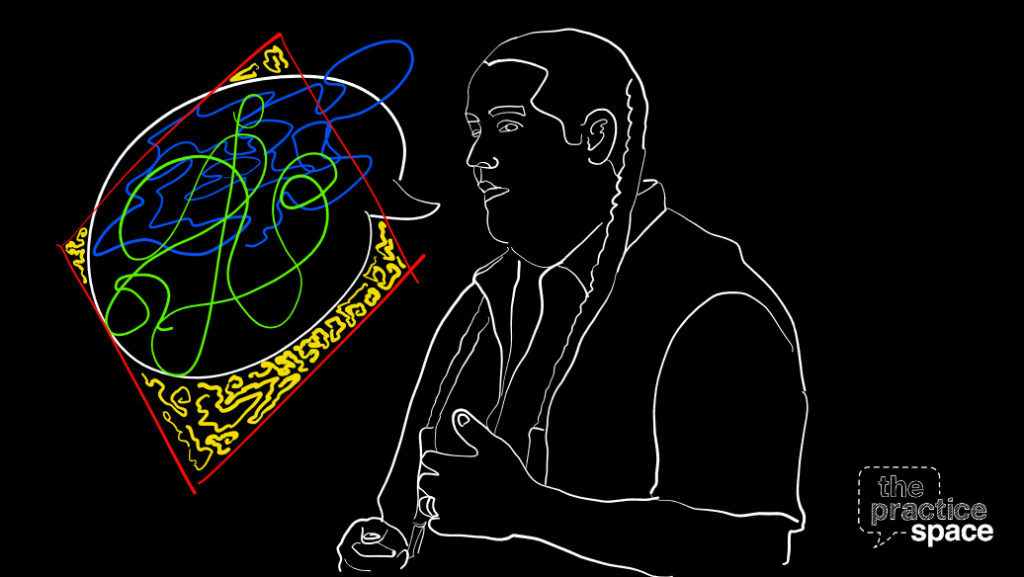Hi! My name is Amber; I’m an intern at The Practice Space. Today, I’m going to talk about a speech that I watched this past year while learning about the connections between indigenous identity, art, expression, and sovereignty. I am going to recount the speech, explaining the speaker’s message and technique and how he is such an effective public speaker. I am going to ground my explanation in what I have learned from the speaker about identity and communication, and how I hope to grow as a part of the public speaking community under the guidance of his words.
As a non-indigenous person, I am learning how to make space for indigenous people in my life, my activism, and my speech. One way to honor indigenous people is by starting communication with an acknowledgement of the indigenous land on which one resides. I have realized that recognizing the experience and identity of the people you are speaking to is just as important as honoring your own identity in your speech. And, even when your audience may not include indigenous people, acknowledging and valuing the historical and contemporary experiences of indigenous people in all speech helps put these ideas into practice. TPS team member Diana reflects, “land acknowledgment is also a growing practice many people use in community collaborative spaces as a way to remember and uplift indigenous communities. Knowing/acknowledgment of which peoples lived on the lands we now occupy is a growing equity practice in many spaces.” The Practice Space resides on the traditional land of the Lisjan Ohlone people, whose territory includes the five bay area counties: Alameda, Contra Costa, Solano, Napa and San Joaquin. I would like to honor the land itself and the Lisjan Ohlone people with gratitude for the resources and care that have allowed The Practice Space to exist and grow.
Land acknowledgement is also how the speech I am about to recount begins. It sets a message that is communicated throughout the speech: that indigenous people are here, and must be included in our actions and speech to begin the process towards rematriation and equity.
The speech is called “Indigenous in Plain Sight”, and was delivered by Gregg Deal at a TEDx event in Boulder, Colorado. The lights are low, but not so dim you can’t see the speaker, and the materials projecting onto screens. Gregg begins with an acknowledgement of the Arapaho, Ute, and Cheyenne people, who are the indigenous tribes whose land Colorado occupies. The Arapahoe Nation is the primary group that lives in the Boulder Valley region. He reminds the audience: “even though they may not be here, this is still their land, this is still indian land, and everywhere on this continent is indian land.”
He introduces himself. His voice has a bluish gray tint to it, comforting, but speaking with deep intention and gravity. Gregg frames his motivation and roots his values in the context of his family: he is a husband, a father, and a member of the Paiute Tribe of Pyramid Lake. These are the identities that inform his artistry, his activism, and his speech. He projects images up onto the screen: of his family, but also of his art. Messages of decolonization, historical indigenous experience, erasure, stereotypes, and identity stand out as he flashes through photos of performance art and snapshots of murals. He says, “the value of indigenous people is really low in the eyes of America and in the eyes of American culture. That there is a hierarchy that is set within those spaces that immediately tells every child and ultimately every adult that is having education here in the United States what our value is.” His delivery is powerful, posing adeptly phrased questions that encourage the audience to think about their own role in the perpetuation of oppressive systems. “So, for example, we know who Christopher Columbus is. But we don’t know the name of the people he came into contact with. I mean, I know. You guys might not know.” The audience laughs, because Gregg is very skilled at framing things in a way that makes the audience think critically within humor. And he was right — as a graduate of the US school system, having learned all about Christopher Columbus (initially as a hero and later as a terrible, terrible person, an executor of genocide), I could not remember the name of the people he met when he travelled to the Caribbean. By the way, they are called the Taíno people, and their culture has influenced much of the “beliefs, religions, language, and music of Caribbean cultures” (Library of Congress). Even as history has been retold to admit the horrors committed by non-indigenous people, it is still focused on the western figure. The narrative still does not give value to indigenous people. This realization made me think again about my role as a speaker, and how important it is to acknowledge and uplift others by knowing when to speak and when to listen. Being a leader is seeking out the truth and paying attention to others’ authentic communication.
Gregg continues to share stories, some of them his, some of them belonging to others. He relays his experience of his art and his stories being rejected from forums meant for indigenous people, because they don’t make sense, or they reflect truth that non-indigenous audiences prefer to not see. His goal is to communicate, not to placate. His speaking style is unique and non-conforming, and he tells us that his intention with his art is to exist outside a western buyers’ market. He shows this art, and explains the history behind it. He tells the audience of a young boy who was forced into a boarding school, one of hundreds of institutions “where culture was literally beaten out of indigenous children”, many of which remained active until the 2000s. The audience remains quiet as he reminds them that under the hierarchy established by western society, the story of this boy does not matter. Gregg disagrees. I disagree. The story of this boy is one of the most important stories I have encountered, because it is a story that has not been heard by most. It has been buried by a culture of oppression, but it is true, and it is terrible, and it is what we all need to hear. I think Gregg’s speech exemplifies why storytelling is so powerful — these stories, his speech, his presence are an act of protest and a demonstration of strength.
Finally, he tells the audience that they are now responsible, that they must now reflect and act. He reminds us that his message is not a passing academic consideration, but an action to embody. “Stories are to be carried, stories are to be held, stories are to be revered.” He reminds us that inaction is complicity, and that it is the duty of non-indigenous people to ask themselves if they are making spaces for indigenous voices, acknowledging their roles in oppressive systems, and honoring the indigenous people who were here before them. I think this message is even more impactful from a speaker’s perspective, because it reminds us that we speak with purpose. Most of us speak because we want to have a space to express our identity, our needs, and the things we care about. Gregg has reminded us that we have another purpose: to speak for the needs and identities of others, to connect with others through the things we care about, and to make space for all in our world of speaking. Gregg’s speech is over, and as a final comment, he asks: “what are you going to do with that information?”
I hope my observations will encourage you to learn more about the speaker! I also suggest that anyone who is interested in this speech checks out related content created by indigenous authors and artists, including Tai Simpson, DRMNGNOW, Red Eagle, The Halluci Nation, and DJ Shub. For an academic approach, here are some indigenous scholars who have written work on the connection between speech, sound, and indigenous identity: Dylan Robinson, Michelle Raheja, Tanya Tagaq, and Heather Igloliorte.
Sources: I found the information about indigenous lands on the websites for “Whose Land”, the Boulder Healing Hub, and Sogorea Te’ Land Trust.



